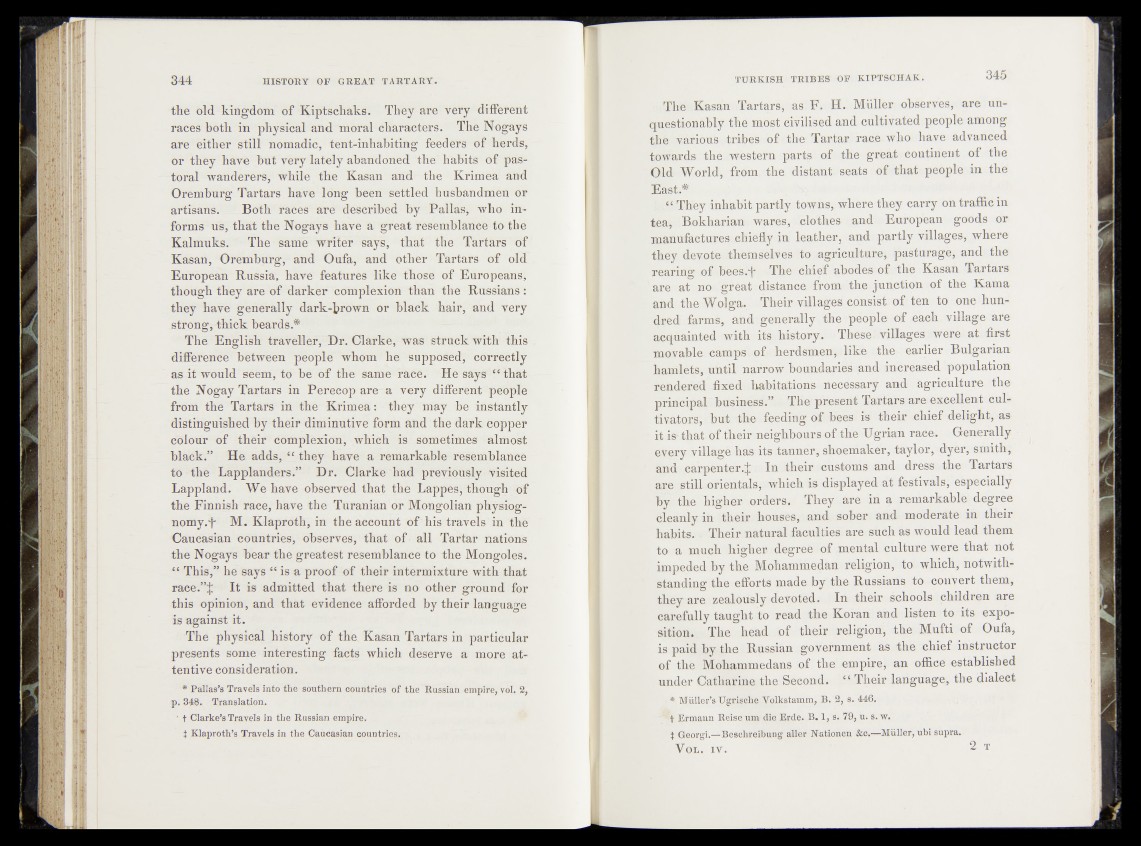
the old kingdom of Kiptschaks. They' ire very different
races both in physical and moral characters. The Nogays
are either still nomadic, tent-inhabiting feeders of herds,
or they have hut very lately abandoned the " habits of pastoral
wanderers, while the Kasan and the Krimea and
Oremburg Tartars have long been settled husbandmen or
artisans. Both races are described by Pallas, who informs
us, that the Nogays have a great resemblance to thd
Kalmuks. The same writer says, that the Tartars of
Kasan, Oremburg, and Oufa, and other Tartars of old
European Russia, have features like those of Europeans,
though they are of darker complexion than the Russians :
they have generally dark-brown or black hair, and very
&trong}-thick beards.*
The English traveller, Dr. Clarke, was struck with this
difference between people whom he supposed, correctly
as it would seem, to be of the same race. He says“ lhat
the Nogay Tartars in Pereeop are- a very different 'people-
from the Tartars in the Krimea: they may be instantly
distinguished by their diminutive form and the dark eopper
colour of their complexion, which is sometimes almost
black.” He adds, “ they have a remarkable resemblaneC
to the Lapplanders.” Dr. Clarke had previously visited
Lappland. We have observed that the Lappes-, though of
the Finnish race, have the Turanian or Mongolian physiognomy.
b M. Klaproth, in the account of' his travels' in the
Caucasian countries, observes, that of all Tartar nations
the Nogays bear the greatest resemblance to the Mongoles.
“ This,” he says t£ is a proof of their intermixture with that
race.”J It is admitted that there is no other ground for
this opinion, and that evidence afforded by their language
is against it.
The physical history of the. Kasan Tartars in particular
presents some interesting facts which deserve a more attentive
consideration.
* Pallas’s Travels into the southern countries of the Russian empire, vol. 2,
p. 348. Translation.
■ t Clarke’s Travels in the Russian empire.
t Klaproth’s Travels in the Caucasian countries.
The Kasan Tartars* as F. H. Midler observes, are unquestionably
the mos^ ivilised and cultivated people among
the various v-tribesabJrf','the’ Tartar race who have advanced
towardsi the«wëstern parts of the great, continent of the
Obi* World*, from, the distant: seats, of that people in the
East.* , V
L >6rTh?qy dnhabltepart%« towns, where thi|icarry on traffic in
tea, Bokhariann wares, clothes J and European goods or
manufacturesmhiëfty in leather, and ^partly villages, where
they devote, themselves to agriculture, pasturage* and the
rearing of bees-.'f The chief' abodes^of the Kasan Tartars
"are at no3;rg,reatidistance from^tl^jainctioh of the Kama
and the Wolga. Their villa^éepps|êi: of ten to oneffiun-
cj#ed farms, and generally/fcipeople of each, village are-
acquainted with its history. Tfedm villages were, at first
movableicampSi of- herdsmen flikte .the- earlier Bulgarian
hamlets, until narrow boundaries and'increased 'population
rendered fixed habitations necessary and agriculture the
principal business.”. The1 present Tartars are excellent cul-
tiv*Moxs,': hut the feeding of bees is their .chief delight, as
I ft is» that of their ^neighbours of the -U grian race. Generally
every .village has itslanner, shoemaker, taylor,'dyer, smith,
and carpenter4?» In . their -customs and dress -the Tartars
are still-orientals, which-is displayed at .festivals, especially
by the higher orders. They&are in a remarkable degree
cleanly in their houses, andi sober and moderate in. their
habits. - Their natural faculties are.such as would lead them
to a much higher, degree of mental culture were that not
impeded by the Mohammedan; religion, to which, notwiths
standing the efforts made by the Russians to convert them,
they* are zealously devoted. In their schools, children are
carefully taught to read the Koran and listen to its exposition.
The head of their religion, the Mufti of Oufa,
is paid by the Russian government as the chief instructor
of the Mohammedans of the. empire, an office established
under Catharine the Second. “ Their language, the dialect
'' *• * Müller’s Ugrische Volkstamm, B. 2, s. 446.
"5 j| Er maun Reise unvote' Erde* B. 1, s. 79, u. s. w.
j Georgi.—Beschreibung aller Nationen &c.—Müller, ubi supra.
Vol. H I 2 T